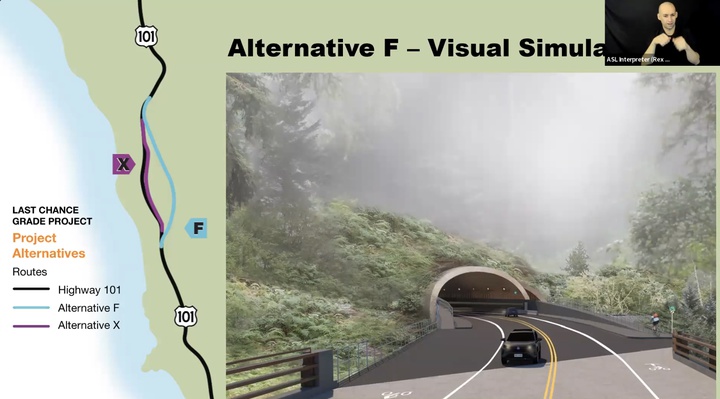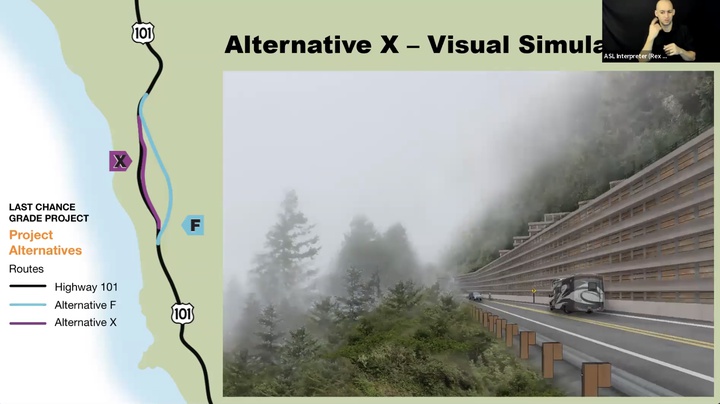Jessica Cejnar Andrews / Thursday, Dec. 21, 2023 @ 5:06 p.m. / Infrastructure, Roads
Caltrans Releases Last Chance Grade Draft Environmental Impact Report For Public Comment

A 6,000 foot tunnel is one of two options Caltrans is considering for a bypass around Last Chance Grade. | Visual simulation courtesy of Caltrans District 1
Caltrans has opened the public comment period on a draft environmental impact report focusing on the two alternatives for a bypass around Last Chance Grade.
The department released the document to the public about 10 days after District 1 Director Matt Brady told state transportation commissioners that they were about a year ahead of schedule on the project approval and environmental document phase.
The draft EIS also comes about two months after U.S. 101 reopened to two-way traffic in the slide-prone area for the first time in roughly nine years. A weather-driven landslide about two weeks ago halted traffic again for a short time, Brady told California Transportation Commissioners who met in Riverside on Dec. 7.
“When this slide happens and this area goes down… people can’t get through to have, say, kidney dialysis in Eureka,” Brady said. “And people that are on the south side, Yurok Tribal members, can’t get to school on the north side. Commerce stops as well because there are a number of farms, dairy farms, agricultural farms up near Smith River.”
A virtual open house focusing on Last Chance Grade is planned for 5:30-7 p.m. Jan. 24, 2024. The deadline to comment on the draft EIR is Feb. 13, 2024.
The two-lane road through that 3-mile long stretch is slowly moving into the ocean, Brady said. In some places it’s sunk by about 30 feet and inched westward by about 40 feet, he said.
Caltrans’ draft environmental impact statement focuses on two proposed fixes: Alternative F, which includes a 6,000 foot-long tunnel and would cost an estimated $1.9 billion, and Alternative X, an end-to-end re-engineering of the highway that would cost an estimated $810 million.
According to Jaime Matteoli, Caltrans District 1 corridor manager, Alternative F, the tunnel option, would include an on-site operations and maintenance center. While there are many large diameter old growth trees that would have to be removed, Matteoli said the department is moving the alignment as close to the edge of the forest as possible.
Caltrans will also build a bridge over a wetland and would offer elevated bike paths, Matteoli said.
Alternative X would look a lot like the current highway, Matteoli said. Caltrans would try to mitigate the landslide by installing a dewatering system that pulls moisture out of the landslide to try to slow or stop it. The project would also involve moving the highway further east to “gain more time and real estate in areas of coastal erosion.”

Alternative X would continue to incorporate retaining walls into the highway. | Visual simulation courtesy of Caltrans District 1
Motorists would also see new larger retaining walls on the uphill side if Caltrans went with Alternative X, Matteoli said.
“This alternative would also require the removal of sensitive trees and coastal erosion would remain a long-term challenge for Alternative X,” he said.
At the CTC’s meeting, Tamera Leighton, executive director for the Del Norte Local Transportation Commission, urged commissioners to visit Last Chance Grade.
“There’s nothing like seeing it,” she said. “You stand there on that cliff, you can see the ocean beneath you, you can see the failures above you. It’s breathtaking, the scope of this project is breathtaking as is the scope of the solution.”
District 3 Supervisor Chris Howard pointed out that during the Smith River Complex wildfire, with U.S. 199 shut down, U.S. 101 was Del Norte County’s only link with the rest of California.
“Our whole community was out of power for eight days. The whole community,” Howard said. “And so, we’re in a situation now, and we have been for quite a long time, where sometimes this is literally our only lifeline out of the county. Thi sis our only connectivity to the rest of the State of California.”
Transportation commissioners also heard from Humboldt County supervisors Rex Bohn and Michelle Bushnell.
To provide public comment, submit them in writing to Steve Croteau, North Region Environmental at PO Box 3700 Eureka, CA 95502 or email DEDcomments@lastchancegrade.com.
CLICK TO MANAGE